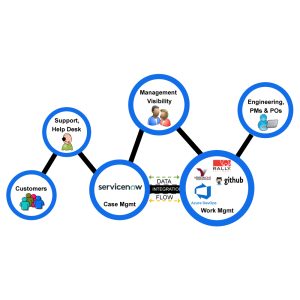Managing requirements in large-scale enterprise systems is a critical challenge. These systems often involve thousands of interdependent components, spanning multiple teams, departments, and even organizations. The complexity grows as regulatory requirements, security protocols, and evolving business needs continuously reshape the project landscape.
Enterprises operating in industries like aerospace, defense, automotive, and IT infrastructure cannot afford fragmented or inconsistent requirements management. Misalignment between stakeholders, lack of traceability, and inefficient collaboration can lead to significant cost overruns, compliance failures, and project delays.
This is where IBM Engineering Requirements Management DOORS (Dynamic Object-Oriented Requirements System) provides a structured, scalable, and traceable approach to managing requirements efficiently. This blog explores the depth of IBM DOORS capabilities, its role in handling enterprise complexity, and how organizations can leverage its full potential to scale requirements management without compromising on accuracy or compliance.
The Growing Complexity of Enterprise Requirements Management
As systems become more interconnected and multidisciplinary, managing their requirements presents several key challenges. Let break them down in detail:
1. Volume and Granularity of Requirements
Enterprise systems may have millions of requirements, spanning different levels of abstraction:
- Business Requirements: High-level goals that define the purpose of the system.
- System Requirements: Derived specifications dictating overall system behavior.
- Software & Hardware Requirements: Technical constraints and functional details.
- Regulatory & Compliance Requirements: Standards like ISO 26262, DO-178C, IEC 61508, and GDPR, which dictate operational and safety compliance.
Each layer must be linked, managed, and updated throughout the project lifecycle, making manual or document-based approaches impractical.
2. Traceability and Change Management
Large-scale projects are not static; they evolve as stakeholder needs, market conditions, and regulations change. However, unstructured requirement changes can cause misalignment between teams, leading to unintended consequences.
- Forward Traceability: Ensures every requirement has a corresponding design, implementation, and validation test.
- Backward Traceability: Tracks each system function back to its original requirement, preventing scope creep.
- Change Impact Analysis: Evaluates how a change affects dependencies across subsystems, mitigating risk before implementation.
Without robust traceability mechanisms, organizations struggle to maintain consistency across their projects.
3. Collaboration Across Distributed Teams
Enterprise systems are rarely developed by a single team. They involve multiple business units, external partners, and geographically dispersed stakeholders. Miscommunication, siloed data, and version control issues can disrupt workflows, leading to:
- Duplicated efforts when teams work on different requirement versions.
- Security risks when requirement changes are not tracked properly.
- Project delays due to inconsistencies in interpretations across different teams.
IBM DOORS addresses these challenges by providing centralized, role-based access, ensuring controlled and seamless collaboration.
4. Regulatory Compliance and Auditability
Industries like aerospace, automotive, healthcare, and finance require strict adherence to industry standards. Non-compliance can result in:
- Product recalls in automotive and aerospace industries.
- Regulatory fines for failing to meet data privacy laws.
- Delayed certifications preventing products from reaching the market.
To stay compliant, enterprises must demonstrate complete auditability of requirements, changes, and decision-making processes. IBM DOORS provides automated compliance tracking, historical logging, and validation workflows to support these needs.
How IBM DOORS Addresses Large-Scale Requirements Management
IBM DOORS is a highly structured and scalable requirements management platform designed to handle enterprise complexity. Below is a detailed breakdown of how it supports various aspects of requirements management.
1. Hierarchical and Modular Requirements Structuring
Unlike traditional document-based approaches, IBM DOORS enables teams to structure requirements in a modular format, which significantly improves:
- Navigability: Large requirements sets are broken into manageable modules.
- Scalability: Supports thousands to millions of requirements without performance degradation.
- Reuse & Version Control: Teams can reuse existing requirements while maintaining distinct version histories.
IBM DOORS provides a hierarchical breakdown, ensuring requirements are linked from business needs to system design without losing traceability.
2. End-to-End Traceability for Impact Analysis
Traceability is fundamental for:
- Ensuring that system implementations align with original business requirements.
- Verifying test cases against defined requirements.
- Analyzing the impact of requirement changes across interconnected components.
IBM DOORS enables multi-directional traceability, allowing teams to visualize dependencies and assess the effect of modifications before implementation.
3. Built-in Change Management and Version Control
IBM DOORS supports robust version control mechanisms, ensuring that teams can:
- Maintain an audit trail of all changes.
- Revert to previous versions if required.
- Implement change approval workflows to prevent unauthorized modifications.
This ensures consistency across long-term, large-scale projects.
4. Regulatory Compliance and Audit Readiness
DOORS simplifies compliance management by offering:
- Predefined templates for industry standards like ISO 26262, DO-178C, and CMMI.
- Automated reporting features for audits and regulatory submissions.
- Access control mechanisms ensuring role-based compliance enforcement.
5. Seamless Integration with Engineering and DevOps Tools
IBM DOORS does not operate in isolation it integrates with enterprise ecosystems through:
- IBM Engineering Lifecycle Management (ELM): Linking requirements to design, development, and testing.
- Third-Party Tool Support: Integrates with JIRA, MATLAB, IBM Rational Team Concert (RTC), and more.
- Automated Testing Frameworks: Ensuring validation of requirements against implemented systems.
This enables organizations to achieve a unified development and compliance workflow.
Best Practices for Scaling Requirements Management with IBM DOORS
To maximize IBM DOORS’ potential, enterprises should follow these best practices:
1. Define a Clear Requirement Taxonomy
Organizing requirements into a structured hierarchy improves traceability and simplifies navigation.
2. Establish Strong Governance Policies
- Define approval workflows for requirement modifications.
- Implement access control to restrict unauthorized changes.
- Automate audit reporting to ensure regulatory readiness.
3. Automate Requirement Validation
Leverage automated test case generation to verify that all implemented functionalities align with defined requirements.
4. Maintain Continuous Requirements Evolution
- Regularly update requirement baselines to align with business changes.
- Use IBM DOORS integrations to ensure alignment between development, testing, and deployment.
5. Implement Role-Based Collaboration Workflows
Define clear roles for:
- Requirement Engineers (author and validate requirements)
- Systems Architects (ensure alignment with system design)
- Test Engineers (validate compliance and functionality)
How Nexright Helps Enterprises Leverage IBM DOORS
At Nexright, we specialize in enabling enterprises to maximize IBM DOORS capabilities for large-scale requirements management. We help organizations:
– Implement and Optimize IBM DOORS to fit unique enterprise workflows.
– Integrate DOORS with Engineering and DevOps Pipelines for a unified lifecycle.
– Ensure Compliance Readiness with automated audit and reporting frameworks.
– Provide Custom Training and Support for seamless enterprise adoption.
Managing requirements at scale requires structured methodologies, automation, and expert guidance. Nexright ensures that enterprises can scale with confidence, meeting compliance, collaboration, and efficiency demands without compromise.
Ready to optimize your requirements management strategy? Contact Nexright today.




